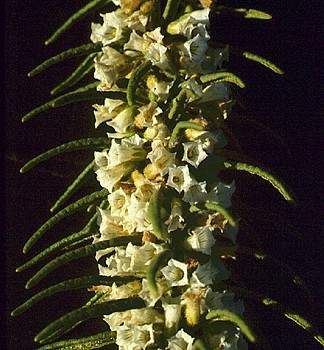Taxonomy
Symonanthus Haegi, Telopea 2: 175 (1981); after David Symon (1920–), Australian systematic botanist prominent in the taxonomy of Australian Solanaceae; and the Greek anthos (a flower).
Type species: Symonanthus bancroftii (F.Muell.) Haegi, based on Isandra bancroftii F.Muell.
Isandra F. Muell., S. Sci. Rec. 3: 2 (1883), nom. illeg., non Salisb., Gen. Pl. Fragm. 67 (1866).
Type species: Isandra bancroftii F.Muell.
[Anthocercis auct. non Labill.; C.A.Gardner, Hooker's Icon. Pl. ser. 5, 4: t. 3382 (1939).]
Dioecious shrubs or undershrubs, pubescent with non-glandular and glandular hairs. Leaves alternate, simple, sessile. Flowers solitary or in cyme-like groups, terminal or on short lateral branches, actinomorphic or slightly zygomorphic, subtended by pairs of opposite bracts. Calyx campanulate to cupular, 5–lobed. Corolla narrowly tubular with erect or spreading limb, white with purple striations in tube; limb 5–lobed, the lobes short, induplicate in bud. Stamens 4 or 5, occasionally 3, equal, inserted at base of corolla-tube; a staminode sometimes present; anthers bilocular, cohering, dorsifixed, dehiscing by longitudinal slits. Ovary bilocular. Stigma capitate, very shortly bilobed. Fruit a smooth capsule, opening from apex by 4 valves, more or less enclosed by calyx. Seeds ellipsoid. n=36; L.Haegi, loc. cit. (1981).
A genus of 2 species endemic in south-western W.A. Dioecious state not obvious as female flowers have a distinct androecium but sterile anthers, while male flowers have an obvious but sterile gynoecium.
L. Haegi, Australian genera of the Solanaceae, in J. G. Hawkes et al., Linn. Soc. Symp. Ser. 7: 121–124 (1979); L. Haegi, A conspectus of Solanaceae tribe Anthocercideae, Telopea 2: 173–180 (1981).
Changes since the Flora of Australia treatment
There have been no changes in the number of species since the Flora of Australia treatment.
Phylogenetic studies by Garcia & Olmstead (2003) on the Tribe Anthocercideae using two chloroplast DNA regions indicated that Symonanthus is monophyletic but its relationship to the rest of the Anthocercideae and Nicotiana is not resolved. Tribe Anthocercideae is monophyletic if Symonanthus is not included within it.
Reference: V.F.Garcia & R.G.Olmstead (2003). Phylogenetics of Tribe Anthocercideaea (Solanaceae) based on ndhF and trnL/F sequence data. Systematic Botany 28: 609-615.
Key to species
Undershrub to 25 cm tall; branches and lower surface of leaves pubescent with glandular hairs; leaves 5–17 mm long; corolla-tube urn-shaped; filaments pubescent at base
Symonanthus bancroftii
Shrub to 1.3 m tall; branches and lower surface of leaves densely villous with loosely matted non-glandular hairs and smaller glandular hairs; leaves usually 20–45 mm long; corolla-tube elongate funnel-shaped; filaments glabrous
Symonanthus aromaticus


